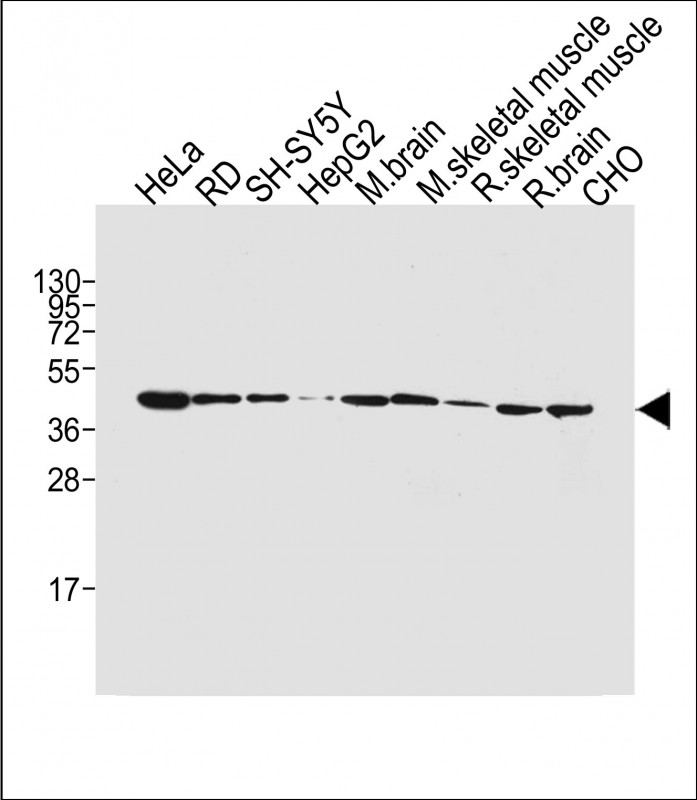
| WB | 咨询技术 | Human,Mouse,Rat |
| IF | 咨询技术 | Human,Mouse,Rat |
| IHC | 咨询技术 | Human,Mouse,Rat |
| ICC | 技术咨询 | Human,Mouse,Rat |
| FCM | 咨询技术 | Human,Mouse,Rat |
| Elisa | 咨询技术 | Human,Mouse,Rat |
| Aliases | Class E basic helix-loop-helix protein 41, bHLHe41, Class B basic helix-loop-helix protein 3, bHLHb3, Differentially expressed in chondrocytes protein 2, hDEC2, Enhancer-of-split and hairy-related protein 1, SHARP-1, BHLHE41, BHLHB3, DEC2, SHARP1 |
| Entrez GeneID | 79365 |
| WB Predicted band size | 50.5kDa |
| Host/Isotype | Mouse IgG2b |
| Antibody Type | Primary antibody |
| Storage | Store at 4°C short term. Aliquot and store at -20°C long term. Avoid freeze/thaw cycles. |
| Species Reactivity | Human, Mouse, Rat |
| Immunogen | This BHLH3 antibody is generated from a mouse immunized with a recombinant protein of human BHLH3. |
+ +
以下是3篇涉及BHLH3(N-term)抗体的参考文献概览:
---
1. **文献名称**: *"DEC1 and BHLHE40 regulate circadian gene expression in mammalian cells"*
**作者**: Honma S. et al.
**摘要**: 该研究利用BHLH3(N-term)特异性抗体,通过免疫共沉淀和ChIP实验证明DEC1(BHLHE40)与核心生物钟蛋白相互作用,并调控下游基因的节律性表达。抗体验证显示其对N端表位的高特异性。
---
2. **文献名称**: *"The role of BHLHE40/DEC1 in hypoxia-induced metabolic reprogramming of cancer cells"*
**作者**: Kim J.W. et al.
**摘要**: 研究使用BHLH3(N-term)抗体进行Western blot和免疫荧光分析,发现DEC1在低氧条件下通过N端结构域介导糖酵解相关基因的转录激活,促进肿瘤细胞代谢适应性。
---
3. **文献名称**: *"Tissue-specific expression patterns of BHLH transcription factors revealed by N-terminal-targeting antibodies"*
**作者**: Müller C. et al.
**摘要**: 该文献开发并验证了针对BHLH家族多个成员N端结构域的多克隆抗体,包括BHLH3.通过免疫组化证实BHLH3在神经和肌肉组织中高表达,且其N端表位在不同物种间高度保守。
---
4. **文献名称**: *"Functional characterization of BHLHE40 in macrophage polarization using epitope-specific antibodies"*
**作者**: Lee Y. et al.
**摘要**: 研究利用BHLH3(N-term)抗体进行流式细胞术和免疫印迹,证明DEC1通过N端结构域抑制M2型巨噬细胞标记物表达,提示其在免疫调控中的关键作用。
---
**备注**:BHLH3常被称作DEC1或BHLHE40.上述文献中的抗体均针对其N端区域,并应用于功能机制研究。建议结合具体实验需求进一步查阅全文。
The BHLH3 (N-term) antibody is designed to target the N-terminal region of the basic helix-loop-helix (bHLH) transcription factor 3. a member of the bHLH protein family. These proteins are characterized by a conserved bHLH domain, which facilitates DNA binding and dimerization, enabling regulation of gene expression involved in cellular processes like differentiation, proliferation, and apoptosis. The N-terminal region often contains unique sequences critical for functional specificity, making it a strategic target for antibodies to minimize cross-reactivity with other bHLH family members.
BHLH3 plays roles in developmental pathways, tissue homeostasis, and disease contexts, including cancer, where it may act as an oncogene or tumor suppressor depending on cellular context. The antibody is commonly used in techniques such as Western blotting, immunohistochemistry (IHC), and immunofluorescence (IF) to study BHLH3 expression, localization, and interactions in biological samples. Its specificity for the N-terminus helps distinguish BHLH3 from homologous proteins, enhancing experimental accuracy.
Research applications include exploring BHLH3's involvement in stem cell regulation, neurogenesis, and tumorigenesis. Validations often involve knockout controls or peptide blocking assays to confirm target specificity. This tool is valuable in both basic research and translational studies aiming to elucidate bHLH protein networks and their therapeutic potential.
×